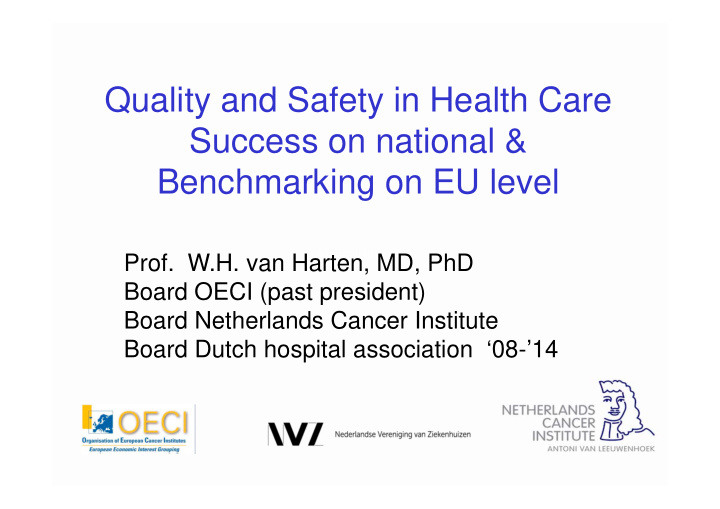



Quality and Safety in Health Care Success on national & Benchmarking on EU level Afbeeldingen Afbeeldingen Prof. W.H. van Harten, MD, PhD Board OECI (past president) Board Netherlands Cancer Institute Board Dutch hospital association ‘08-’14
Patient Safety program Netherlands • 2005 Development of Patient Safety Management System (pilot nine hospitals) • 2007 National Study on preventable harm in Dutch hospitals • 2008 Start Dutch National Patient Safety Collaborative • 2013 Second study preventable harm in Dutch hospitals (
National Patient Safety Program Supporting all hospitals • Supporting all 90 hospitals • National agreement on patient safety in (Dutch) ISO-norm and in 10 projects • Collaborative approaching: Exchanging experience & knowledge • (Publicised) Checks Government & knowledge
Selected themes • Prevent surgical site infection • Prevention of injury in patients with sepsis incl. central venous line • Early recognition of patients with threatened vital functions • Prevention of medication errors, mainly attention on transfer times • Prevention of accidental avoidable harm to elderly patients, with specific attention on: a. recognising and preventing confusion (delirium); b. falls; c. loss of mobility; d. malnutrition 4
Example • Prevent surgical site infections • Goal: reduce infection for all hospitals to the P25 level in 2007 for all hospitals • Interventions: • adequate use of prophylactic antibiotics • discontinuing preoperative shaving • monitoring of door movements
Adverse Events in Dutch Hospitals • 80% hospitals certified/accredited by end 2012 on ISO safety management! • Report 2008: 1960 (1600-2360) preventable? 5,5% in-hospital mortality • Preventable harm: 2,9% total admissions • (International data: 1800-6300 deaths??) • Report 2011/12: 970 (738-1274) 2,7% in- hospital mortality • Preventable harm?: 2,6% total admissions
Succesfactors Safety Improvement National Approach Major agencies involved. Collaborative approach Multicomponent Multi intervention Management and professionals Public reporting Formal evaluation
Crossing the chasm….. Activities with impact/added value on EU level…. Benchmarking Comprehensive Cancer care
BenchCan • Objective: Benchmark comprehensive cancer care & yield best practice examples • Contribute to improving the quality of interdisciplinary patient treatment and transparent patient info • IOM definition: Effectiveness, Efficiency, Safety, Timely, Integrated
BenchCan objectives 1. To collect, compare and align by consensus formation the standards, recommendations and accreditation criteria of comprehensive cancer care in selected European countries 2. To review and refine a benchmarking tool that can be applied to comprehensive cancer care through interdisciplinary patient treatment 3. To pilot the benchmark tool with particular attention to operations management and best clinical practice
Pilot sites Central/East North/West South
13 steps 1. Determine what to benchmark 2. Form a benchmarking team 3. Choose benchmarking partners 4. Define and verify the main characteristics of the partners 5. Identify stakeholders 6. Construct a framework to structure the indicators 7. Develop relevant and comparable indicators 8. Stakeholders select indicators 9. Measure the set of performance indicators 10. Analyze performance differences 11. Take action: results were presented in a report and recommendations were given 12. Develop improvement plans 13. Implement the improvement plans
Framework
BenchCan Indicators Indicators (max. 100?) derived from literature and expert opinions Safety : Specific outcomes such as: Complication rates, Incidents report system, pressure ulcers, Sepsis/catheter days; Work safety. Which strategies are implemented to ensure patient safety System to monitor and present survival and mortality data
BenchCan Piloting Data collection indicators & External review visit: 1-2 day visit of pilot sites Pre-pilot 3 institutes data collection completed Data set revision and preparation Consumer Quality Index survey. Pilot 8 institutes data collection February-May
BenchCan Results: Online free accessible (peer reviewed) benchmarking manual Best practice examples publicly available Deliverables: May 2016
BenchCan Consortium Organization of European Cancer Institutes(OECI) The Netherlands Cancer Institute “Antoni van Leeuwenhoek” (NKI/AVL) Institut Gustave Roussy (IGR) Health ClusterNET (HCN) PANAXEA Alleanza Contro il Cancro (ACC) National Institute of Oncology (NIO)
Thank you for your attention
Recommend
More recommend